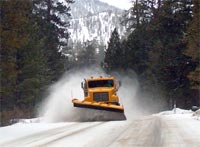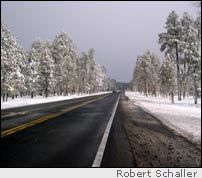Planning a road trip through snow and ice?
These road-tested tips from professional driving instructor Bob Schaller will help keep you safe, warm, and on track. RTA's Road Food Guru Dennis Weaver tells how to stay hydrated and nourished in cold weather.
GET PREPARED Before you drive, clear the snow and ice from the windows, hood, lights, and roof. Keep your vehicle clean to help you be more visible to others. Vehicle maintenance is always important, but even more so in weather extremes. Be sure all these systems are in good working order—ignition system, fuel system, belts, hoses, fluids, brakes, exhaust system, wiper blades and operation, heater and defroster, cooling system, battery, and lights. Make sure you have winter-grade oil in the crankcase. Keep the fuel tank full—don't let it get below half before filling up. Add gasoline antifreeze if necessary.
Tires and Traction: You should have at least 1/8-inch tire tread depth and proper inflation. Cold temperatures have a lowering effect on tire pressures—check frequently to maintain adequate inflation. Carry chains or invest in winter tires (for mud and snow). In some states, you can use studded snow tires, but they are illegal in others. Traction devices often greatly increase your stopping distance, so control your vehicle carefully. "All-season" tires are not your best choice for poor conditions outside the sanded, sheltered streets of a city—make sure you have good lugged snow tires if you are traveling through heavy snow country. Know the difference between standard brakes and ABS brakes, (click here for more about this) and how to use each. When using ABS, press the brake and hold it. Do not release the pressure. With standard brakes, use threshold braking. Press the brake pedal until the wheels begin to lock, then release just enough pressure to get them rolling again. It is important to have your brakes serviced so they do not pull to one side or the other. Recommended Equipment:
This is no time to get stuck with a flat tire, so make sure you have a jack, lug wrench and an inflated spare tire in good condition. Get last minute information on weather and road conditions—your state's Department of Transportation (DOT) Web site is the best place to start. (For more links to weather forecasting and reporting, click here.) You need the latest information—weather FORECASTS (like those in newspapers) are notorious for unreliability! Ask about any potential avalanche conditions along your route. Last but not least: Let someone know where you are going and when you plan to arrive. GET GOING First, buckle up. (For more about this, click here.) Then, don't get in a hurry. Reduce your speed according to the conditions. Reduce speed by 30% in rain, 50% in snow. If the road is icy, reduce more than that. While it is important not to drive too fast, it's also important to keep moving and not go too slow—you need momentum to keep your vehicle chugging ahead through snow, especially on grades. Keep a light touch on the controls. When driving in snow and ice, smoothness is the key. Sudden moves will almost certainly result in loss of traction on slippery roads, and at that point you are just a passenger—you go wherever the car goes! More than any other factor, even experience and skill, smoothness will keep you going. Think ahead and leave room for stopping or maneuvering before the vehicle begins to respond to conditions. You need at least 8 to 10 seconds of following distance in winter conditions, and MORE if the road might be icy. Brake early, brake slowly, brake smoothly. If your wheels lock, you lose control, so keep 'em rolling. Don't be overconfident because your vehicle has traction control, four-wheel drive, front-wheel drive, or any other device that makes you think you can speed through weather conditions faster than other folks. Remember that 4WD does not provide any advantage in braking. It will take just as long as any other vehicle to get it stopped. Don't use electronic speed control if you might encounter slippery stretches of roadway. If you lose traction and the vehicle begins to skid, gradually let up from the accelerator but do not touch the brakes. Steer the vehicle gently toward the direction you want it to go. When the tires begin rolling again, slow gently and stop if you need to. Take a deep breath. This always works for me…
More things to keep in mind: Beware of Carbon Monoxide. Do not start your car in an enclosed area and let it idle with the cabin closed up. Remember that bridge surfaces, shadows, and low spots where water can collect will be the first areas to freeze. Remember that driving in poor conditions is fatiguing—leave plenty of time for rest stops and don't push it if you are feeling tired and sleepy. If you get stuck, generally, the best thing is stay in your vehicle and keep warm while you wait for help. Again, be careful about carbon monoxide, and check your exhaust pipe. Clear away snow, ice, or anything that might be blocking it. Don't take short cuts in winter—keep to the main roads. Back roads may not be plowed or patrolled, and if you get stuck, you may be out there a long time. Maybe until Spring... Robert
Schaller |


